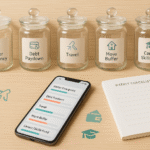If you’re juggling multiple balances and wondering how to get out of debt faster, you’ve likely heard of the debt snowball and debt avalanche methods. Both are proven frameworks for organizing payments, building momentum, and eliminating what you owe. Yet they’re not the same—and the method you choose can shape your motivation, the interest you pay, and even the complexity of your monthly routine. This guide breaks down the top five differences between debt snowball and debt avalanche methods, shows you exactly how to implement either one, and helps you pick the right fit for your situation.
Disclaimer: This article is educational and not individualized financial advice. Everyone’s money situation is unique. Consider speaking with a qualified financial professional for guidance tailored to your goals and constraints.
Key takeaways
- Debt snowball prioritizes smallest balance first for quick wins; debt avalanche targets highest interest rate first for maximum interest savings.
- Avalanche is typically more cost- and time-efficient, while snowball often provides faster motivation and visible progress.
- Your behavioral fit matters as much as the math—momentum and adherence can outweigh minor differences in cost.
- Consider complexity and data needs: avalanche requires accurate APR data and ongoing updates; snowball is simpler to run.
- Choose based on your debt profile, psychology, and risk—and remember you can blend or switch methods without losing progress.
1) Prioritization Logic: Smallest Balance First vs. Highest Interest First
What it is and the core purpose
- Debt Snowball: List all debts by balance (smallest to largest). Pay minimums on everything, then throw any extra money at the smallest balance first. When it’s gone, roll that old payment onto the next smallest—your payment snowballs as you go.
- Purpose/benefit: Creates quick wins by closing out accounts early, which can boost motivation and help you stick with the plan.
- Debt Avalanche: List all debts by APR/interest rate (highest to lowest). Pay minimums on all accounts, then direct extra cash to the highest-rate debt first. After that’s paid, move to the next highest rate.
- Purpose/benefit: Minimizes total interest paid and can shorten overall payoff time compared to snowball, especially when high-APR balances are large.
Requirements and low-cost alternatives
- Snowball needs: Current balances and minimum payments for each account.
- Low-cost tools: A simple spreadsheet or notebook; a free payoff calculator can help but isn’t required.
- Avalanche needs: Accurate APR for each debt, balances, and minimums.
- Low-cost tools: Your statements (for APRs), a spreadsheet, or free calculators that sort by interest rate.
Step-by-step (beginner-friendly)
Snowball
- Write down each debt’s balance and minimum payment.
- Order debts from smallest balance → largest.
- Pay minimums on all debts; direct every extra dollar to the smallest.
- When the smallest is paid off, roll its payment onto the next smallest.
- Repeat until debt-free.
Avalanche
- Write down each debt’s APR, balance, and minimum.
- Order from highest APR → lowest.
- Pay minimums on all; direct extra money to the highest APR.
- When it’s gone, roll payments to the next highest APR.
- Repeat until debt-free.
Beginner modifications and progressions
- Snowball (simplify): If you don’t know every APR, start anyway—balances are enough to begin.
- Avalanche (progression): Once comfortable, refine with daily interest estimates or use a payoff calculator that accounts for changing APRs and promo rates.
Recommended cadence and metrics
- Update your list monthly (after statements generate).
- Snowball KPIs: Debts closed per quarter; months between first and second payoff.
- Avalanche KPIs: Interest saved month over month; projected debt-free date.
Safety, caveats, mistakes to avoid
- Don’t skip minimums. Late fees and credit damage will erase your gains.
- Verify APRs (avalanche). Mis-sorting by interest rate defeats the method’s purpose.
- Avoid new debt. Charging up balances during payoff stalls momentum.
Mini-plan example (2–3 steps)
- Snowball: (1) Pay minimums on all; add extra $150 to the $450 store card. (2) After payoff, add that full payment to the $1,100 visa.
- Avalanche: (1) Pay minimums on all; add extra $150 to the 27% APR card. (2) Next, roll all payments to the 21% APR card.
2) Cost and Timeline: Motivation vs. Math on Interest Savings
What it is and the core purpose
- Snowball: Trades some interest efficiency for speedy wins. You’ll often pay a bit more interest overall, but you’ll likely see an account hit zero sooner.
- Avalanche: Prioritizes interest optimization. By attacking high-APR balances first, you usually pay less interest and may finish faster overall.
Requirements and low-cost alternatives
- Snowball: Needs minimal data—great if gathering APRs is hard.
- Avalanche: Requires accurate APRs and may need more frequent updates if variable rates change.
Step-by-step to compare the math (easy version)
- Total your minimum payments across all debts.
- Decide on a fixed extra-payment amount.
- Run both plans side by side in a spreadsheet or calculator to estimate total interest and payoff date.
- Choose the approach that best balances cost savings and personal motivation.
Beginner modifications and progressions
- If the difference in interest between methods is small (say, similar APRs), choose the one you’ll stick with.
- If the difference is large (one balance has a much higher APR), consider avalanche or a hybrid (see below).
Recommended cadence and metrics
- Monthly: Track remaining principal, interest charged, and time to next payoff.
- Quarterly: Re-run your projection to reflect rate changes and extra-payment opportunities (tax refunds, bonuses).
Safety, caveats, mistakes to avoid
- Don’t chase microscopic optimizations at the expense of consistency. Missing payments costs far more than a perfect spreadsheet saves.
- Watch for intro APRs expiring; when they do, the priority order may change.
Mini-plan example (2–3 steps)
- Avalanche bias: (1) Direct extra money to the 24% APR card. (2) When a 0% promo ends on another card, re-sort and attack that if it jumps above 24%.
- Snowball bias: (1) Kill the smallest $300 balance this month for an early win. (2) Roll the freed $60 minimum plus your extra $100 to the next balance.
3) Behavioral Fit: Quick Wins vs. Long-Haul Discipline
What it is and the core purpose
- Snowball: Leans into psychology—finishing a small debt early can be an emotional boost and a proof-of-concept. That confidence can carry you through a long journey.
- Avalanche: Rewards discipline and comfort with delayed gratification—you may not see a quick account closure, but the numbers quietly work in your favor.
Requirements and low-cost alternatives
- Snowball: Works with the bare minimum of data and is easy to teach a partner or accountability buddy.
- Avalanche: Best if you’re comfortable with numbers, rate tracking, and monthly recalculations.
Step-by-step to find your fit
- Reflect on past habits: Do small wins keep you going, or do cost savings motivate you?
- Test-drive each method for one billing cycle with the same extra-payment amount.
- Keep whichever felt easier and more satisfying, then commit for at least 90 days.
Beginner modifications and progressions
- Try a hybrid: Start with snowball for 1–2 quick closures, then switch to avalanche for the rest.
- Use visual trackers—thermometers, spreadsheets, or habit apps—to simulate small wins even in avalanche.
Recommended cadence and metrics
- Weekly: Check-in on habits (no new charges, spending triggers avoided).
- Monthly: Celebrate a milestone (percent paid down, consecutive on-time payments).
Safety, caveats, mistakes to avoid
- Don’t self-sabotage by labeling yourself “bad at math.” You can automate most avalanche calculations with a basic template.
- Avoid plan hopping every few weeks. Frequent switching erodes momentum.
Mini-plan example (2–3 steps)
- (1) Use snowball to close the $200 medical bill this month for a morale boost. (2) Shift to avalanche next month to hammer the 25% APR card.
4) Complexity & Data Needs: Simplicity vs. Precision
What it is and the core purpose
- Snowball: Simple and stable. Once you order by balance, the sequence doesn’t change unless you make large extra payments or a balance transfer.
- Avalanche: Data-intensive. APR changes, promos, and variable-rate products can require re-sorting and updated projections.
Requirements and low-cost alternatives
- Snowball: A paper list and a pen can run the entire plan.
- Avalanche: Statement APRs, accrual details, and occasionally daily periodic rates if you want to get exact.
Step-by-step for managing complexity
- Collect: Balances, minimums (both methods); APRs (avalanche).
- Sort: By balance (snowball) or APR (avalanche).
- Automate: Use calendar reminders for due dates and a recurring extra-payment transfer.
- Review: Once a month, update balances and APRs; re-sort avalanche if needed.
Beginner modifications and progressions
- If APRs are missing, start with snowball, then transition to avalanche when you’ve gathered rates.
- As you progress, add what-if scenarios (e.g., “What if I add $50 more each month?”).
Recommended cadence and metrics
- Monthly: Verify APRs on credit cards (promo end dates, penalty rates).
- Quarterly: Audit your interest charges—expect to see them shrink as principal falls.
Safety, caveats, mistakes to avoid
- Autopay minimums wherever possible to avoid fees and credit damage.
- Beware deferred interest promotions; a retroactive charge can upend your priority order.
- Avoid closing old accounts impulsively after payoff; this can affect your credit history length and utilization.
Mini-plan example (2–3 steps)
- (1) Turn on autopay for every minimum. (2) Add a calendar task titled “APR check + re-sort list” on the first business day each month.
5) Suitability by Debt Type & Risk: One Size Doesn’t Fit All
What it is and the core purpose
- Snowball: Often best where debts are numerous with similar APRs, or where motivation is the limiting factor.
- Avalanche: Shines when you carry high-APR revolving debt or have a large spread between your highest and lowest rates.
Requirements and low-cost alternatives
- Snowball: Works well with installment loans (fixed-rate student or auto) mixed with small revolving balances—simplify by clearing the little ones quickly.
- Avalanche: Crucial when variable-rate credit cards or lines of credit have high APRs—prioritizing these generally reduces cost the most.
Step-by-step by common scenario
- Mostly credit cards (high APRs): Use avalanche; verify APRs monthly and re-sort after any promo changes.
- Many small balances + a few medium ones: Start snowball for 1–3 fast closures, then switch to avalanche.
- 0% intro balance transfer present: Temporarily de-prioritize the 0% balance (until promo ends), but plan for its go-to APR before it spikes.
Beginner modifications and progressions
- Try a tiered hybrid: First, kill any balances under $500 (snowball tier). Then flip to avalanche until done.
- If decision fatigue hits, appoint a “default method”—for example, avalanche unless two balances are within $100, then choose the smaller (a motivational tiebreaker).
Recommended cadence and metrics
- Monthly: Track credit utilization and on-time payment streak.
- Quarterly: Review debt-type mix (revolving vs. installment) and refine priorities if rates or balances shifted.
Safety, caveats, mistakes to avoid
- Don’t let teaser rates distract you from total cost. Always plan for the post-promo APR.
- If a debt is in collections, check the statute of limitations and consider getting advice; payment timing can have legal implications.
- Avoid minimum-only habits on high-APR revolving balances; this is where avalanche really earns its keep.
Mini-plan example (2–3 steps)
- (1) Clear two sub-$400 store cards this month (snowball). (2) Switch to avalanche and attack the 25% APR card next.
Quick-Start Checklist
- List all debts with balance, minimum payment, and APR (if available).
- Choose snowball (smallest balance first), avalanche (highest APR first), or a hybrid.
- Set a fixed extra-payment amount you can sustain each month.
- Turn on autopay for minimums to protect your credit.
- Create a monthly review date to update balances/APRs and re-run your projection.
- Decide in advance how you’ll celebrate milestones (first payoff, 25% paid off, etc.).
- Commit to 90 days without switching methods unless there’s a major change (new promo APR, windfall, emergency).
Troubleshooting & Common Pitfalls
- “I missed a payment.” Immediately pay the past-due amount and the current minimum. Add a late-fee buffer to your emergency fund.
- “A promo APR just ended.” Re-sort your avalanche list; if it’s now your highest APR, it jumps to the front.
- “I keep using my cards.” Consider a cash-only period or a low-limit debit for daily spending. Track triggers (late-night online shopping, boredom).
- “My partner isn’t on board.” Run both methods side-by-side for 12 months in a spreadsheet. Let the numbers and the pace of wins guide a shared decision.
- “I’m overwhelmed.” Default to snowball for 1–2 fast closures, then reassess. Quick wins can restore focus.
- “Interest keeps eating my payments.” Revisit your budget to free up an extra $25–$100 monthly; in avalanche, small increases compound into large interest savings.
- “Should I consolidate?” If you qualify for a lower fixed rate and won’t add new debt, consolidation can help—just run the numbers including fees and the loan term.
How to Measure Progress (So You Don’t Lose Steam)
- Debt-free date (projected vs. actual): Update monthly.
- Total interest paid YTD: Expect a decline as principal falls (especially with avalanche).
- Balances closed (snowball): Celebrate each account zeroed out.
- Credit utilization: Track revolving balances compared with total credit limits; reductions can support your credit profile.
- On-time payment streak: Protect it relentlessly—payment history is a key driver of most scoring models.
- Extra-payment streak: Count consecutive months you hit your extra-payment goal.
A Simple 4-Week Starter Plan
Week 1 – Set the foundation
- Pull balances, minimum payments, and APRs.
- Choose your method (snowball, avalanche, or hybrid).
- Turn on autopay minimums and schedule your extra payment.
- Draft a one-page payoff map and stick it on the fridge (or a shared drive).
Week 2 – Optimize cash flow
- Trim $50–$150 in monthly spending (subscriptions, dining out).
- Add those dollars to your extra-payment amount.
- If using avalanche, confirm promo end dates and recalculate your order.
Week 3 – Execution and habits
- Make your first extra payment on your priority debt.
- Do a no-spend weekend to build momentum.
- Create a visual tracker (debt thermometer or progress bar).
Week 4 – Review and refine
- Update balances; confirm APRs didn’t change.
- Celebrate wins (first debt down? first 5% reduction?).
- Decide whether to maintain the method or switch to hybrid for month two if motivation lagged or rates changed.
FAQs
1) Which method is “better”—debt snowball or debt avalanche?
“Better” depends on your goal. If you want to pay the least interest and can stay motivated without quick account closures, avalanche typically wins. If you need early wins to stick with the plan, snowball may be more effective for you.
2) Can I mix the two methods?
Yes. A popular hybrid is to close one or two small balances with snowball, then switch to avalanche for the remainder.
3) What if my highest-rate balance is also my largest?
That’s common with credit cards. Consider avalanche to minimize interest. To stay motivated, set micro-milestones (every $300 or $500 paid down) and celebrate them.
4) How do these strategies affect my credit?
Consistent on-time payments and lower credit utilization usually help your credit profile over time. Be cautious about closing old accounts after payoff; it can affect your history length and utilization.
5) Should I prioritize 0% promo balances?
Usually not until the promo ends. Track the expiration date and the go-to APR. Re-prioritize when the rate changes.
6) What if my rates change mid-plan?
That’s an avalanche-specific trigger to re-sort your list. For snowball, your order typically stays the same unless balances change materially.
7) Is it ever smart to pay only minimums?
If cash is tight or you’re building a basic emergency fund, minimums may be a short-term necessity. But to accelerate payoff, aim to add any extra—$25–$50 a month compounds meaningfully.
8) Do balance transfers help?
They can if you qualify for a lower effective rate and pay off the transferred balance before the promo ends (watch fees and the post-promo APR).
9) What about consolidating with a personal loan?
A fixed-rate installment loan can simplify payments and lower your rate. Compare total interest and fees, and avoid racking up new credit card debt afterward.
10) How big should my emergency fund be while paying off debt?
A common approach is one month of essentials to start, then increase as debts fall. Even a small buffer prevents backsliding when surprises hit.
11) Do I need fancy software or apps to do this well?
No. A simple spreadsheet or notebook works for snowball. Avalanche benefits from a calculator but can still be run with a basic sheet and your statements.
12) How long until I see results?
You’ll see progress immediately—either a smaller balance (avalanche) or a closed account (snowball). Most people feel a motivational lift within the first 30–60 days, especially when tracking milestones.
Conclusion
The debt snowball and debt avalanche methods are two road-tested ways to take control of your balances. One prioritizes human motivation; the other prioritizes mathematical efficiency. The “best” method is the one you’ll execute consistently, month after month. Start with the approach that fits your psychology and your debt profile, and don’t be afraid to adjust as you learn more about what keeps you moving.
CTA: Pick your method today, make your first extra payment this week, and begin your debt-free streak—one decision, one month, one win at a time.
References
- Debt Snowball Method: How It Works, When to Use It, NerdWallet, May 6, 2025. https://www.nerdwallet.com/article/finance/what-is-a-debt-snowball
- How to Use the Debt Avalanche Method to Pay Off Debt, NerdWallet, August 1, 2025. https://www.nerdwallet.com/article/finance/what-is-a-debt-avalanche
- How to reduce your debt, Consumer Financial Protection Bureau, July 16, 2019. https://www.consumerfinance.gov/about-us/blog/how-reduce-your-debt/
- Debt Snowball vs. Debt Avalanche Method, Experian (Ask Experian Blog), July 15, 2024. https://www.experian.com/blogs/ask-experian/avalanche-vs-snowball-which-repayment-strategy-is-best/
- Debt Avalanche: Meaning, Pros and Cons, and Example, Investopedia, December 24, 2023 (updated). https://www.investopedia.com/terms/d/debt-avalanche.asp
- Debt Avalanche vs. Debt Snowball: What’s the Difference?, Investopedia, August 7, 2016 (updated; check page for current revision). https://www.investopedia.com/articles/personal-finance/080716/debt-avalanche-vs-debt-snowball-which-best-you.asp
- Comparing Debt Snowball and Debt Avalanche Methods, Business Insider, April 30, 2025. https://www.businessinsider.com/personal-finance/investing/debt-snowball-vs-debt-avalanche
- What’s in my FICO® Scores?, myFICO (Credit Education), accessed August 2025. https://www.myfico.com/credit-education/whats-in-your-credit-score
- Can Small Victories Help Win the War? Evidence from Consumer Debt Management, Journal of Marketing Research (Gal & McShane), August 2012. https://journals.sagepub.com/doi/abs/10.1509/jmr.11.0272
- Can Small Victories Help Win the War? Evidence from Consumer Debt Management (full text PDF), authors’ repository, August 2012. https://www.blakemcshane.com/Papers/jmr_debt.pdf
- Two steps forward, one step back? Quantifying the pecuniary and behavioral costs of debt repayment strategies, Southern Economic Journal (Hamilton et al.), 2023. https://onlinelibrary.wiley.com/doi/full/10.1002/soej.12612
- The ‘snowball approach’ to debt, Kellogg Insight/Northwestern University, August 7, 2012. https://insight.kellogg.northwestern.edu/article/to_beat_debt_consider_starting_small
- Average Credit Card Interest Rate for August 2025: 23.99% APR, Investopedia, August 2025. https://www.investopedia.com/average-credit-card-interest-rate-5076674
- Consumer Credit – G.19 (Current Release), Board of Governors of the Federal Reserve System, August 7, 2025. https://www.federalreserve.gov/releases/g19/current/
- Vanguard’s guide to financial wellness (on prioritizing high-interest debt), Vanguard, 2024. https://corporate.vanguard.com/content/dam/corp/research/pdf/vanguards_guide_to_financial_wellness.pdf






